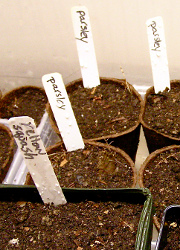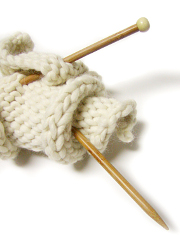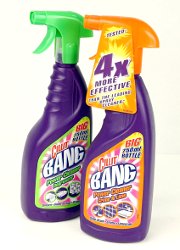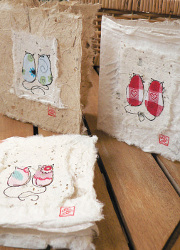 It might still be February but our 2011 growing season is already off and running here.
It might still be February but our 2011 growing season is already off and running here.
In addition to the eight fruit trees John planted a couple of weeks ago, I planted out eight fruit bushes at the weekend and I started my first batch of cauliflower, greenhouse tomatoes and lettuce the weekend before last. Following a recommendation from The Cottage Smallholder, I’ve bought a heated propagator to give my other greenhouse crops – cucumbers, chillis, pepper & tomatoes – a warm start in life — I’m hoping that arrives in the post today so I can get started with them ASAP.
For the first few sowings, I can remember what is where — the lettuce are in the troughs & square pots, the tomatoes in the round ones, the caulis in the fibre ones – but in a few weeks, I won’t be able to remember where everything is. And outside, we’ll want to know next year (and the year after, and the year after that) which fruit trees & bushes are which variety.
In the past, I’ve used slices of drinks cans or plastic milk bottles as plant markers – and they work reasonably well if you remember to write on them using a permanent marker (which I didn’t do last year – lots of confusion mid-year). I also know other people who use ice lolly sticks (but there has been an unacceptable dearth of those consumed here in the last year) and the like. And some people buy white sticks to use as labels – buy? buy?! not I! ;)
Do you reuse or recycle any packaging or bits of “waste” to label your plants or seedlings? Do you have any suggestions for making long term labels – ones that’ll be weather-resistant for at least a few years?
(Photo by normanack)
Categories: garden, hobbies, reverse this
Posted by louisa
on 15 February 2011
 We’ve had another email from friend of Recycle This Petra:
We’ve had another email from friend of Recycle This Petra:
From my sister in law I inherited a lot of yarn, mostly small balls of the same. I know you covered the item about the short ends of yarn and what to do with it. My question is a bit related.
A lot of the yarn is white or off-white. Not a colour I would choose for knitting a sweater for myself. And also for my kids, white is not a very
handy choice. Moreover, most of the yarn is synthetic, which I don’t really like to wear and makes it difficult to paint in a different colour.
So, my question is: What can I do with that white yarn? It is a box full of yarn (20 by 30 by 20 cm).
It’s not the right season to be thinking about it but my first thought was snowflake Christmas decorations (Mary Horesh recommended this crochet pattern on Twitter when she made them in December) – but if you used all of the yarn to make snowflakes, it would be more like a 10ft deep blizzard rather than a pretty delicate sprinkling of decorative snow ;)
Looking forward rather than back, I don’t wear white or choose to wear synthetics either but a lot of people do – and spring & summer are the months when a little white shrug or cardigan might be useful – perhaps keep some and pass the rest on to someone else via Freecycle/Freegle or Ravelry’s destash area.
Any other suggestions of patterns of things to make with it (ideally not clothes)? Or places to pass it on?
(Photo by missa88)
Categories: clothes and fabric, hobbies, items
Posted by louisa
on 14 February 2011
 We’ve already covered old duvets before really but we’ve had an email from Gill:
We’ve already covered old duvets before really but we’ve had an email from Gill:
I have 6-8 used but still serviceable quilts and pillows and no-one seems to want them. The local homeless shelter says they don’t take donations and I’ve contacted several charities who I thought might use them (rather than selling them for recycling) but no-one is interested as they are not ‘good as new’. Even the local PDSA won’t take them for animal bedding.
Any suggestions as I’d rather they were put to good use as quilts rather than scrap.
I’m surprised that shelters for both humans and animals won’t take them, especially if they’re machine washable. Perhaps offer them on your Freecycle/Freegle group – someone on there might be happier to receive them than charities obeying “no used stuff” policies.
On our local Freegle group, people frequently as for “anything for a new home” so they might want them. There also might be people who want them to use for other things – not for their original purpose but not for fabric reclamation/recycling either – for example, using the quilts for making insulating blinds or to make mattress/pillow protectors.
Pillows can also be upcycled – they can be “squared-off” to make cushions, used for animal bedding (nesting building dogs love having a selection of pillows to dig around in), made into draught excluders/draft dodgers or bolsters, or the stuffing reclaimed for all sorts of craft projects.
Does anyone else have any other suggestions where might take USED quilts and pillows? Or have any more recycling ideas for pillows?
Categories: clothes and fabric, household, items
Posted by louisa
on 11 February 2011
 Shelagh emailed to ask:
Shelagh emailed to ask:
How can I reuse a Cillit Bang spray? It seems impossible to remove the nozzle to fill with a product.
I’ve never used it so I don’t know what the bottle is like – but I’m going out to the shops in a few minutes so I’ll have a good look at one (that’s guaranteed to get me some weird looks in the cleaning aisle ;) ). I’ll also check what type of plastic it is for recycling purposes (my guess would be HDPE, plastic number 2, which is widely recycled, but I’ll check).
We’ve covered pump action spray bottles before – people reuse them as plant spritzers or personal misters, or refill them with vinegar or homemade cleaning solutions to make their own cleaning sprays — but all of those reuses require getting into the bottle again. Anyone got any helpful hints on how to remove the nozzle section from a Cillit Bang bottle without breaking it?
Any other reuse ideas for if the nozzle section is stuck on?
Categories: bathroom, household, items, kitchen
Posted by louisa
on 9 February 2011
Since it’s coming up to Valentine’s Day, I thought it might be nice to have a round up of fun recycling/upcycling Valentine’s Day crafts – for inspiration or purchase!

- Andrea Cook has been making cute Valentine’s Day cards out of recycled handmade paper and fabric scraps. Coupled-up kitties!
- Sarah from Wrapped up with String has also been making pretty recycled paper cards.
- And Alison Bailey Smith told us: “I pulped up lots of paper, in different colours & add hearts using plastic from advent calendars to make cards” – cute idea.
- The Spotted Sparrow has come up with some fun print-and-make ideas: a book of love coupons or an old fashioned library card. I like the idea of reusing the latter each year but that’s possibly because I’m cheap ;)
- Not strictly Valentine’s-y but I love this notebook made from recycled materials – an old shirt, beer mats and reclaimed tissue paper have been used to make it. It would make a fab diary.
- We saw the equivalent at Christmas but I still love the idea of magazines being upcycled into garlands – using a heart-shaped punch and a sewing machine, this Valentine’s Day garland is made in next to no time. (A flower seed catalogue would work well too – pretty coloured flowers a-go-go – and they’re very common at this time of year.)
- Another way to make a heart garland is to curve strips into hearts – and hearts within hearts. Lots of pretty examples made from maps, old books, music scores and other vintage papers…
- If your loved one is, like mine, not exactly the most punctual person in the world – how about a heart shaped clock made from an old vinyl record?
- Personally John and I aren’t big Valentine’s people but have been known to bestow the occasional love token upon each other at other times of the year. A couple of years ago, we bought something in a paper bag with red hearts on it – when John was out, I cut out all the hearts and left them in his closed laptop – when he opened it, they flew everywhere – a shower of hearts. :)
Will you be upcycling or recycling anything for your loved one(s) for Valentine’s Day? If so, tell us your plans – if it won’t ruin the surprise ;)
(Thanks to everyone who sent suggestions via Twitter!)
Categories: art & crafts using recycled stuff, Valentines
Posted by louisa
on 8 February 2011
 It might still be February but our 2011 growing season is already off and running here.
It might still be February but our 2011 growing season is already off and running here.


 We’ve had another email from friend of Recycle This Petra:
We’ve had another email from friend of Recycle This Petra: We’ve already
We’ve already  Shelagh emailed to ask:
Shelagh emailed to ask:















